|
|
|
|
|
|
Report
sightings |
|
|
|
|
|
|
Report
sightings |
New Management Plan - 2010 to 2020
A new Management Plan for the Reserve has been drafted to cover the period 2010
to 2020 and is available for public consultation until 13th November. Your
comments are welcomed and should be made to Dawlish Warren Rangers. The plan can
be viewed
here
Saturday 31st:
Vis mig up to 11am revealed the first large pigeon movement of the autumn with 4565 Wood Pigeon, 138 Stock Dove and five Feral (Racing) Pigeon heading west, also heading in the same direction 231 Skylark, 108 Jackdaw, 83 Starling, 50+ Meadow Pipit, c30 Linnet, 20+ Pied Wagtail and 12 Raven with 47 Chaffinch east. Other species on the move included the first two Brambling of the year, six Reed Bunting, five Siskin, four Gadwall, three Bullfinch, two Lesser Redpoll, two Golden Plover, two Pintail, a Buzzard and a Swallow. Elsewhere 40+ Greenfinch, c20 Goldfinch and 18 Linnet were around Greenland Lake, three Chiffchaff and a Great-spotted Woodpecker were in the bushes, a Grey Wagtail was on the Main Pond, a Great Northern Diver, the Eider and 30 Common Scoter were offshore, 22 Turnstone were on the seawall and two Mediterranean Gull, an adult and a first winter, were by the Go-carts.
Friday 30th:
A Firecrest was in Dead Dolphin Wood, with single Chiffchaff and Goldcrest also on site. Elsewhere the female Eider was offshore with a second bird, an eclipse drake, flying south, a first winter Mediterranean Gull was in the estuary and 82 Chaffinch, four Siskin, two Collared Dove and a Lesser Redpoll passed overhead.
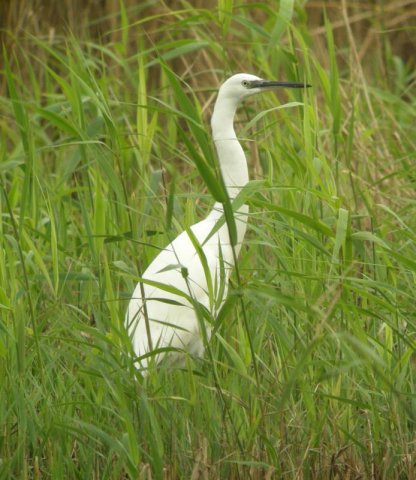
Little Egret 29/10/09 © Lee Collins
Thursday 29th:
The first Ring Ouzel of the year and only the 15th site record was along the Back Path for most of the morning. Elsewhere two Chiffchaff were in the bushes and overhead two Siskin and a Lesser Redpoll.
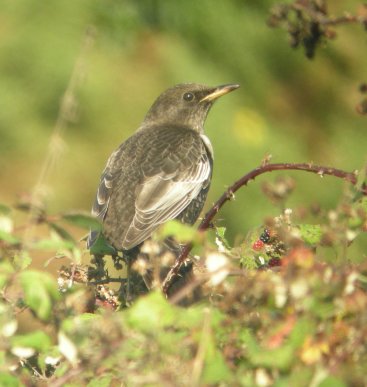
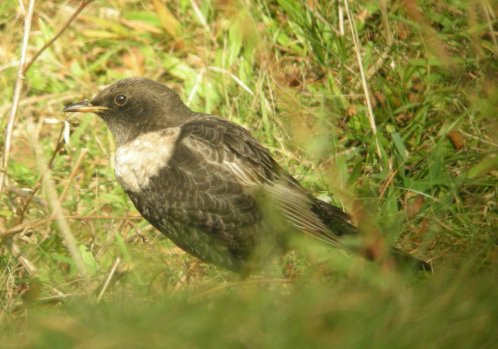
Ring Ouzel 29/10/09 both © Lee Collins
Wednesday 28th:
Vis mig saw the first Crossbill of the year over early morning with 91 Skylark, 88 Wood Pigeon, 16 Jackdaw, 11 Chaffinch and two Lesser Redpoll. Offshore the female Eider is still present with 49 Common Scoter, another Puffin south was a surprise. Elsewhere there were 32 Bar-tailed Godwit, seven Greenshank and a Grey Plover in the estuary and two House Sparrow and a fem/imm Yellowhammer were briefly on the Wryneck path.
Tuesday 27th:
The stiff southerly breeze put paid to any vis mig with records restricted to c40 Skylark, seven Jackdaw, five Chaffinch, a Bullfinch, a Lesser Redpoll and a Swallow. However the conditions were suitable for seawatching with 50+ Kittiwake and c20 Razorbill heading south along with a surprise late Puffin and single Arctic Skua and Manx Shearwater. Also offshore the female Eider and 30 Common Scoter. The Slavonian Grebe remains in the estuary along with 1183 Wigeon, 150+ Great Black-backed Gull, 74 Dark and a single Pale-bellied Brent Goose, 40 Ringed Plover, c30 Knot, 21 Mute Swan, 20+ Black-tailed Godwit, eight Greenshank, five Lapwing and three Mediterranean Gull (2 ad, fw). Elsewhere a Merlin flew south offshore, a Wheatear was in front of the hide, two Reed Bunting were on Warren Point and two Chiffchaff and a Great-spotted Woodpecker were in the bushes.
Monday 26th:
Vis mig revealed many birds heading west, mostly before 9am. Counts included 1345 Wood Pigeon, 294 Skylark, 104+ Meadow Pipit, 75 Jackdaw, 70+ Linnet, 64 Starling, 53+ Pied Wagtail, c40 Goldfinch, 17 Rook, 14 Chaffinch, seven Stock Dove, six Reed Bunting, four Siskin, two Bullfinch, two Grey Wagtail, two House Martin, a Sparrowhawk and a Golden Plover. At least two Peregrine were high over the site preying on the pigeon flocks in particular. Grounded migrants were however notable by their virtual absence, single Firecrest, Coal Tit, Blackcap, Chiffchaff, Goldcrest and Great-spotted Woodpecker were still in the bushes, a Snipe was on Warren Point and at least 60 Greenfinch were around Greenland Lake. The female Eider remains offshore with 70 Common Scoter, four Great-crested Grebe and single Razorbill and Guillemot. Counts from the hide included 870 Wigeon, 200+ Teal, 159 Redshank, 62 Brent Geese, 35+ Black-tailed Godwit, 32 Red-breasted Merganser, 29 Shelduck and five Lapwing in the estuary. Also in the river the Slavonian Grebe, two adult Mediterranean Gull and a first winter Little Gull which flew past the hide and out to sea. Elsewhere a Kingfisher and two Little Grebe were on the Main Pond.
Sunday 25th:
The female Eider was offshore with 30 Common Scoter and 11 Red-breasted Merganser. Elsewhere single Firecrest and Coal Tit were in the bushes with three Chiffchaff, two Blackcap and a Great-spotted Woodpecker also on site and 10 Jackdaw flew over. Just south of the recording area a summer plumaged Red-necked Grebe was off Dawlish.
Saturday 24th:
No news was received for today.
Friday 23rd:
Vis mig recorded 95 Jackdaw, 91 Meadow Pipit, 80 Starling, 77 Skylark, c.75 Greenfinch, 61 alba Wagtail, c.50 Goldfinch, 12 Reed Bunting, 11 Chaffinch, five Song Thrush, five Rook, four Lesser Redpoll, three Collared Dove, three Swallow, two Mistle Thrush and a Grey Wagtail. The Slavonian Grebe was in the estuary with eight Greenshank, seven Ringed Plover and at least two Black-tailed Godwit. Elsewhere a Firecrest was in Dead Dolphin Wood, with six Siskin, two Chiffchaff and single Bullfinch and Great-spotted Woodpecker also in the bushes. The storms earlier in the week have caused further serious damage to the Dune Ridge with several hundred metres of the 1970's sea defences exposed and at least three feet of beach lost.
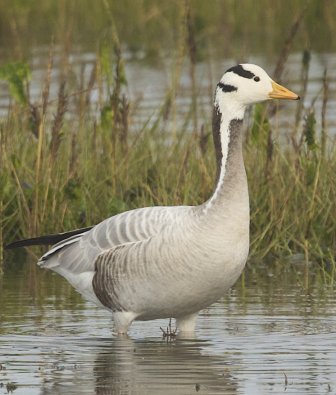
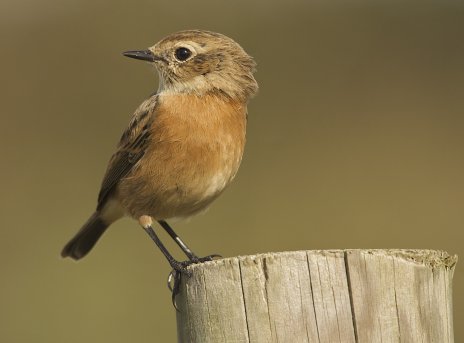
Bar-headed Goose
Stonechat both 23/10/09 © Colin Scott
Thursday 22nd:
The unexpected highlight on an otherwise quiet day was an immature Long-tailed Duck, the first of the year. Initially seen in flight from the hide it was seen again later feeding off Groyne 11, before flying towards Langstone Rock. Elsewhere a Whimbrel was on the beach, 12 Red-breasted Merganser were in the estuary, 45 Dunlin, 12 Ringed Plover, eight Grey Plover, five Knot and two Turnstone were in the Bight, nine Swallow flew though south mid morning, three Chiffchaff were behind the VC and single Snipe, Little Grebe and Little Egret were on the Main Pond. An hour's seawatching was just that!
Wednesday 21st:
Seawatching before 9am saw a steady passage of Gannet with 107 heading south, again Kittiwake were in low numbers with just 11 recorded. Single Red-throated Diver and Arctic Skua added a little bit of quality. In the estuary a female Shoveler with the Wigeon, was the only slightly unusual sighting, also there 74 Brent Geese (just one family party so far), 17 Red-breasted Merganser, six Grey Plover, five Turnstone, two Greenshank, and two adult Mediterranean Gull. Elsewhere 29 Jackdaw and two Swallow flew through and the female Eider was off the seawall.
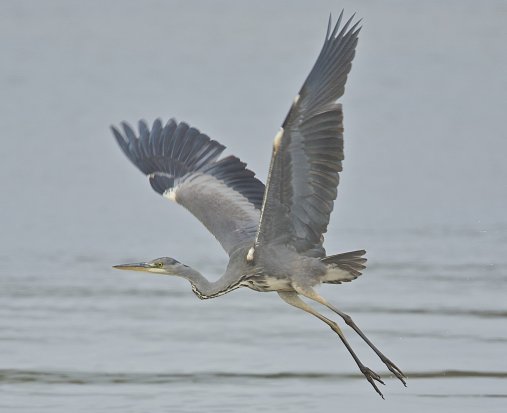
Grey Heron 23/10/09 © Colin Scott
Tuesday 20th:
Once again the weather promised much but the birds failed to live up to expectations - at least at the Warren. Seawatching in the south-easterly gales failed to reveal the Fea's Petrel that passed Budleigh, but in four hours from first light four Great Skua, three Little Gull, two Red-throated Diver, two Mediterranean Gull, an Arctic Skua, single Balearic and Manx Shearwater, a Great-crested Grebe, c120 Gannet, six Fulmar and just eight Kittiwake headed south. Little was recorded elsewhere in the wind and rain, but 173 Dunlin and 22 Turnstone were in the Bight, five Chiffchaff were in the bushes and nine Black-tailed Godwit flew over the buffer zone.
Monday 19th:
The dearth of migrants continues with most species struggling to make it into single figures. Overhead the most notable sighting was a single Tree Pipit, the latest reserve record, other species included 12 Jackdaw, seven Skylark, three Swallow, three Rook, three Chaffinch, two Siskin, two Grey Wagtail, two Raven and a Reed Bunting. In the estuary there was little change with 201 Great Black-backed Gull, 100+ Black-tailed Godwit, 25+ Red-breasted Merganser, 20 Turnstone, eight Shelduck, the Slavonian Grebe and single Greenshank and Mediterranean Gull. Elsewhere 10 Chiffchaff, four Blackcap, the Buzzard and a Great-spotted Woodpecker were in the bushes, a Snipe was on the Main Pond, a Wheatear and a Whimbrel were on the beach and the Eider was again offshore with 60 Common Scoter, 10 Kittiwake, two Sandwich Tern and a distant shearwater sp.
Details have come through of a colour ringed female Great Black-backed Gull, ringed on the nest on 19/05/09 at Ytre Hattholmen, Mandal, Vest-Agder, Norway. It was in the Bight on the Warren on 30/09/09. Thanks to Lee Collins and Nils Helge for this information.
Sunday 18th:
The weather conditions were better than expect with a good covering of high cloud, however movement overhead was still limited. The first autumn flocks of 230+ Wood Pigeon and 66 Jackdaw flew west along with two unidentified 'grey geese', but most birds were heading east. Counts include 70+ Greenfinch, 60+ Goldfinch, 60+ Skylark, 40+ Meadow Pipit, 28+ Siskin, 20+ Chaffinch, 20+ Pied Wagtail, eight Reed Bunting, seven Rook, five Lesser Redpoll, four Great-spotted Woodpecker, four Swallow, four Starling, two Buzzard and two Grey Wagtail. Records from the estuary included a high count of 221 Black-tailed Godwit, 27 Red-breasted Merganser, 15 Grey Plover, two Greenshank, a Mediterranean Gull and the Slavonian Grebe. Elsewhere a Wheatear, a Whimbrel and 10+ Rock Pipit were on the beach, 75+ Common Scoter were offshore, a Great Northern Diver headed north high upriver, before returning, and eight Chiffchaff and three Blackcap were in the bushes.
Saturday 17th:
The reserve's sixth Cetti's Warbler was the highlight. A calling bird was typically elusive around the Main Pond all day, the first since a wintering bird in 06/07. Other grounded migrants were limited to four Chiffchaff, three Blackcap and two Wheatear. There were birds on the move overhead, but the clear conditions meant many will have been missed. Estimated counts include 80+ Goldfinch, 75+ Skylark, 50+ Meadow Pipit, 32 Starling, 30+ Greenfinch, 30+ Chaffinch, 25+ Linnet, 20+ Pied Wagtail, 10+ Siskin, five Reed Bunting, four Jackdaw, four Rook, two Swallow, two Buzzard and singles of Sparrowhawk, Rock Pipit, Bullfinch, Lesser Redpoll and Snipe. Elsewhere a female Eider, the first of the year, 60+ Common Scoter, two Red-breasted Merganser and a Guillemot were offshore, two Whimbrel were on the beach, three Little Grebe and at least two Water Rail were on the Main Pond, a Buzzard and Great-spotted Woodpecker were again on site and in the estuary there were 304 Brent Geese, 50+ Black-tailed Godwit, 12 Turnstone, two Greenshank and a female Pintail.
Friday 16th:
Offshore the re was a settled flock of 82 Common Scoter, with single Great-crested Grebe, Razorbill and Sandwich Tern. Elsewhere two Chiffchaff and a Goldcrest were in the bushes, a Jackdaw was overhead and the Slavonian Grebe was in the estuary.
Thursday 15th:
A Firecrest by the First Pond was
the pick of the grounded migrants with c30 Long-tailed Tit, 10
Chiffchaff, two Great-spotted Woodpecker and a Blackcap also
in the bushes. Another notable migrant was the male
Yellowhammer that joined the transitory
finch flocks in Greenland Lake briefly. Overhead the first
Mistle Thrush of the year headed east
along with c70 Goldfinch, 50+ alba Wagtail, 25+ Meadow Pipit,
20+ Greenfinch, 12 Siskin, 11 Chaffinch, 10+ Linnet,
four Swallow, two Lesser Redpoll, two Rook, a Grey
Wagtail and a Rock Pipit. On a dropping tide the estuary was subject
to much disturbance from bait diggers and their associated dogs, but before they
were flushed three Greenshank, a female Pintail and adult
Mediterranean Gull were on the mudflats with the Slavonian Grebe and
12 Red-breasted Merganser on the water. Elsewhere a Whimbrel and a
Black-tailed Godwit were on the beach, a Buzzard was
again on site, two Little Grebe were on the Main Pond and 40 Common
Scoter were offshore.
Wednesday 14th:
The Slavonian Grebe was off Cockwood and seven Red-breasted Merganser
were offshore but no other news was received.
Tuesday 13th:
Despite reasonable conditions there was less on the move overhead, however a
Yellowhammer east was a good record. Other birds
mostly headed in the same direction included c40 alba
Wagtail, c30 Meadow Pipit, 15+ Skylark, 15+ Linnet, 13
Jackdaw, eight Reed
Bunting, a site record four Great-spotted Woodpecker, two Swallow, two
Bullfinch, two Siskin, a Lesser Redpoll and a Rook. Elsewhere the first
Merlin of the year chased Meadow Pipits
in Greenland Lake, two Sandwich Tern were offshore with 40 Common
Scoter on the sea and 30 more heading south, a Blackcap
and at least four Chiffchaff were in the bushes and a female Pheasant
was in the Back Meadow.
Monday 12th:
Visible migration for two hours early morning produced (all SW unless stated);
171 alba and a Grey Wagtail, 53 Meadow and a Rock Pipit, 45
Greenfinch, 32 Goldfinch, 32 Skylark, 21 Jackdaw, 20
Linnet, 14 Lesser Black-backed Gull (S), seven Reed
Bunting, six Siskin, six Collared Dove, five Swallow,
four Rook, three Snipe and a Sparrowhawk. Elsewhere 37
Brent Geese, nine Sandwich Tern and singles of Greenshank, Kingfisher and adult
Mediterranean Gull were in the estuary.
Sunday 11th:
Visible migration overhead was again noticeable with nearly all species going
SW, 359 Linnet was a site passage record, 193 alba Wagtail and 15 Reed
Bunting were also high counts. Also recorded 90 Meadow Pipit, 70
Greenfinch, 32 Jackdaw, 16 Swallow, 13 Rook, 12
Skylark, seven Snipe, four Chaffinch, four Siskin, two
Grey Wagtail, two Sparrowhawk and singles of Song Thrush,
Kestrel and Raven. On site there were 70 Goldfinch, four
Stonechat, just two Chiffchaff and the Great-spotted Woodpecker.
Elsewhere counts over the high tide included the first three Lapwing of
autumn, 354 Wigeon, 330 Teal, 300+ Curlew, 230 Redshank, 61 Ringed Plover,
29 Knot,
21 Black-tailed Godwit, 10 Grey Heron, seven Dunlin, two Grey Plover,
two Turnstone, a Whimbrel, the Slavonian Grebe and the two Bar-headed Goose
with 160 Canada Geese.
Offshore there was a single Red-throated Diver and two Common Scoter.
Saturday 10th:
Visible migration overhead produced 150+ Meadow Pipit, c.50 Swallow,
43 Skylark, 35 alba and a single Grey Wagtail, 18 Jackdaw,
12 Chaffinch, nine Rook, seven Reed Bunting, two Siskin
and a Collared Dove. On site there were 60 Goldfinch, 25 Linnet,
20+ Long-tailed Tit, 15 Greenfinch, four Blackcap, four
Chiffchaff, four Stonechat, three Wheatear, a Great-spotted
Woodpecker and the Pheasant, with a Kingfisher and a Water
Rail at the Main Pond. In the estuary the wildfowl again suffered frequent
disturbance from weekend boat traffic, the wader roosts were not however
affected and counts included 277 Redshank, 56 Ringed Plover, 45
Bar and at least two Black-tailed Godwit, 41 Knot, five
Dunlin, four Sanderling, four Grey Plover and singles of
Snipe, Greenshank and Whimbrel. Also in the estuary 33
Dark-bellied Brent Geese, 14 Little Egret, seven Grey Heron,
the Slavonian Grebe and a Red-breasted Merganser. Offshore there
were four Sandwich and three Arctic Tern
with 30 Common Scoter.
Friday 9th:
The only news came from the estuary were the Slavonian Grebe and an adult
Mediterranean Gull were still present.
Thursday 8th:
The only news received was of the first Lesser
Redpoll of the year overhead, a Kingfisher and the two Bar-headed Geese
in the estuary with a male Pheasant on site the first for several months.
Wednesday 7th:
No news was received.
Tuesday 6th:
The Slavonian Grebe was still in the estuary but no other news was
reported.
Monday 5th:
The only news came from the estuary were there were 14 Dark-bellied and
three Pale-bellied Brent Geese, two Whimbrel, two Black-tailed
Godwit and an adult Mediterranean Gull.
Sunday 4th:
A Golden Plover was in the estuary
with five Dark-bellied Brent Geese, three Whimbrel, a
Greenshank and the Slavonian Grebe. Offshore there 304 Shag,
170 Black-headed Gull, 40 Common Scoter, 10 Gannet, two
adult Mediterranean Gull, two Sandwich and a Common Tern. A
slight increase in migrants on site included the first Goldcrest of the
autumn, 12 Chiffchaff and seven Blackcap, also present a
Great-spotted Woodpecker, 18 Long-tailed Tit, a high count of eight
Reed Bunting, 80 Greenfinch, 80 Goldfinch, 30 Linnet,
two Song Thrush and a Chaffinch. Overhead there were 30 Meadow
Pipit, 17 Swallow, 14 Siskin, a Skylark, 20 alba and
three Grey Wagtail.
Saturday 3rd:
Counts over high tide included 675 Wigeon, 436 Teal, 407 Curlew,
286 Dunlin, 201 Redshank, 53 Bar and three Black-tailed
Godwit, 33 Knot, seven Ringed and three Grey Plover,
three Pale-bellied Brent Geese, two Whimbrel and the Slavonian
Grebe. Overhead there were just 12 alba wagtail, five Meadow Pipit,
two Grey Wagtail, two Swallow and a Buzzard, with three
Blackcap and three Chiffchaff in the bushes.
Friday 2nd:
Visible migration overhead early morning produced counts of 53 alba Wagtail, 50 Starling, 35 Meadow Pipit, 45 Goldfinch, 20 Linnet, five House Martin, two Swallow, two Kestrel and a Sparrowhawk. Elsewhere 40 Greenfinch, six Blackcap, four Chiffchaff and two Reed Bunting were in the bushes and two Little Grebe and a Kingfisher were on the Main Pond.
Thursday 1st:
An evening roost count smashed the site, and possibly county, record for Canada Geese with 664 in Shutterton Creek, with them were the single Barnacle and two Bar-headed Geese. More welcome wildfowl included 676 Wigeon, 224 Teal, four Pintail and two Brent Geese. Also in the estuary a first winter Mediterranean Gull, two Whimbrel and the Slavonian Grebe. Elsewhere 10 White Wagtail and a Wheatear were on site.
Back |
September 2009 |
Home